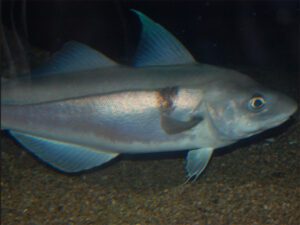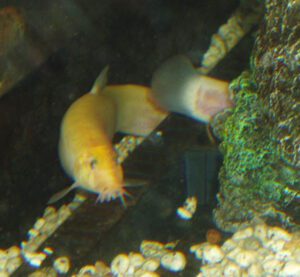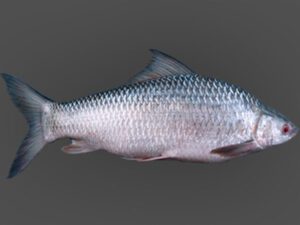The Indian Oil Sardine fish is a species of ray-finned fish in the genus Sardinella.
It is also known by some other names in it’s native area such as Mathi, Chaalai, Kavalai, Maththi, Chaala, Pedvey Padwa, Washi, Tarla, Tharlae, Gisbey and Boothai.
It is one of the 2 most important commercial fishes in India, along with the Mackerel. It is also one of the more regionally limited species of Sardinella and can be found in the northern regions of the Indian Ocean.
Currently the Indian Oil Sardine fish is highly available in it’s native range and is considered as Least Concern. It is distributed from the Gulf of Aden to southwest India, and possibly the Andaman Islands.
The fish is not found in the Red Sea or in the Persian Gulf. Specimens found in the Philippines or in Indonesia were probably misidentifications of Sardinella lemuru. However, read some more information about this fish species below.
Indian Oil Sardine Fish Characteristics
The Body of the Indian Oil Sardine fish is particularly elongated even to the point of being sub-cylindrical. Their belly is slightly rounded and there are 8 rays on their pelvic fin.
They have a very large number of gill rakers and a faint golden spot behind the gill opening. They also have a faint golden midlateral line, as well as a black spot on the hind border of the gill cover.
Average body length of the mature fish is around 20 cm, with a maximum of 23 cm. And maximum recorded body weight of the Indian Oil Sardine fish is 200 grams. Photo and info from Wikipedia.

Diet
The Indian Oil Sardine fish are mainly feed on phytoplankton (especially diatoms), but also on zooplankton.
Breeding
The Indian Oil Sardine fish reach maturity within a year and breeds once a year. The spawners arrive off western coasts of India in June-July when temperatures and salinity are low during the southwest monsoon months. The females generally can lay around 75,000 eggs per spawning.
Uses
The Indian Oil Sardine fish is mainly used for food in it’s native area. It is also used for producing fishmeal and fish balls.
Special Notes
The Indian Oil Sardine fish is commercially fished throughout it’s range, and it is one of the most important species of fish in Indian fisheries.
It is one of the 2 most important commercial fishes in India, along with the Mackerel. It is commercially caught mainly in Karnataka, Goa, Kerala and southern Maharashtra.
The Indian Oil Sardine fish is mainly used for food, but it is also used for making fishmeal and fish balls. It is generally marketed fresh, smoked, canned, dried and dried-salted.
The fish reach maturity within one year, and their average lifespan is between 2.5 and 3 years. However, review full breed profile of this fish in the table below.
| Name | Indian Oil Sardine |
| Kingdom | Animalia |
| Phylum | Chordata |
| Class | Actinopterygii |
| Order | Clupeiformes |
| Family | Clupeidae |
| Genus | Sardinella |
| Species | S. longiceps |
| Binomial Name | Sardinella longiceps |
| Other Names | Also known as Mathi, Chaalai, Kavalai, Maththi, Chaala, Pedvey Padwa, Washi, Tarla, Tharlae, Gisbey and Boothai |
| Breed Purpose | Food, fishmeal, fish balls |
| Special Notes | One of the most important species in Indian fisheries, commercially fished throughout it’s range, used for food, fishmeal and fish balls, reach maturity within one year, 2.5-3 years of average lifespan |
| Weight | Around 200 grams |
| Breeding Method | Natural |
| Climate Tolerance | Native climates |
| Body Color | Silvery with a faint golden spot behind gill opening, followed by a faint golden midlateral line; a distinct black spot at hind border of gill cover |
| Rarity | Common |
| Availability | India |
Indian Oil Sardine Fish Facts
Here are the top Indian oil sardine fish facts that you might not have known.
- Scientific Name: The scientific name of Indian oil sardine is Sardinella longiceps. This fish belongs to the family of Clupeidae.
- Habitat: Indian oil sardines are found in the Indian Ocean, particularly in the coastal waters of India, Sri Lanka, and the Maldives. They are also found in the Arabian Sea and the Bay of Bengal.
- Appearance: Indian oil sardines have a silver-colored body with a blue-green back and a dark spot behind their gills. They can grow up to 25 centimeters in length.
- Nutrition: Indian oil sardines are an excellent source of protein, omega-3 fatty acids, vitamins B12 and D, and minerals such as calcium, phosphorus, and selenium. They are also low in fat and calories.
- Health Benefits: The consumption of Indian oil sardines has been linked to several health benefits, such as improved heart health, reduced inflammation, and enhanced brain function.
- Traditional Food: Indian oil sardines have been a traditional food in India for centuries. They are often prepared as a curry or a fry and served with rice.
- Fishing Techniques: Indian oil sardines are caught using traditional methods such as ring seine nets, drift nets, and gill nets. These methods are considered sustainable and environmentally friendly.
- Seasonal Fish: Indian oil sardines are a seasonal fish that is abundant during the monsoon season, from June to September. During this time, they are caught in large quantities and sold in local markets.
- Export: Indian oil sardines are one of the most important fish species exported from India. They are exported to various countries such as Japan, China, and Thailand.
- Economic Importance: The Indian oil sardine fishery is an important source of livelihood for many coastal communities in India. It provides employment opportunities for fishermen and supports local economies.
- Climate Change: Climate change has had a significant impact on the Indian oil sardine fishery. Changes in sea surface temperatures and ocean currents have resulted in fluctuations in the availability of sardines.
- Population Dynamics: Indian oil sardines are a highly fecund species, with females producing up to 200,000 eggs per year. However, their population dynamics are influenced by various factors such as fishing pressure, predation, and environmental conditions.
- Sardine Oil: Indian oil sardines are a rich source of oil, which is extracted and used for various purposes such as manufacturing soaps, cosmetics, and lubricants.
- Sardine Canning Industry: The Indian oil sardine is an important fish species for the canning industry. Sardines are canned and exported to various countries.
- Sardine Fisheries Management: The Indian government has implemented various fisheries management measures to ensure the sustainable harvest of Indian oil sardines. These measures include fishing quotas, size limits, and fishing gear restrictions.
- Traditional Medicine: Indian oil sardines have been used in traditional medicine.





